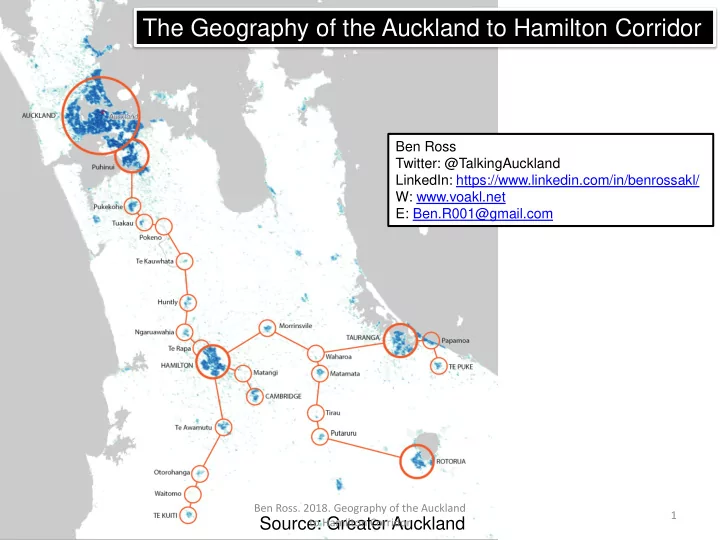

The Geography of the Auckland to Hamilton Corridor Ben Ross Twitter: @TalkingAuckland LinkedIn: https://www.linkedin.com/in/benrossakl/ W: www.voakl.net E: Ben.R001@gmail.com Ben Ross. 2018. Geography of the Auckland 1 Source: Greater Auckland to Hamilton Corridor
Focus: the Upper North Island The central themes around this inter-regional planning are the following: • Most urban growth both residential and industrial will be in Southern Auckland • Industry is decamping from the Southdown-Onehunga complex and moving into Southern Auckland as land use competition with residential and commercial heats up on the Auckland Isthmus • Heavy industry seeks out lower land values with good connections and little land-use competition as mentioned above • Population is spilling out of Southern Auckland and like industry will seek provincial places in the northern Waikato • State Highways 1, 2 27 and 29 form the road spines while the North Island Main Trunk Line and the East Coast Main Trunk Line form the rail spines between Auckland, Hamilton and Tauranga • The Golden Triangle forms 50% of the national population and 50-60%% of national GDP • Role of Manukau City Centre into the future Ben Ross. 2018. Geography of the Auckland 2 to Hamilton Corridor
Population load spreading – saving the Provinces and Auckland at the same time • Rapid urbanisation has seen provincial centres without decent industry hollow out while the main urban centres continue boom and expand. This is not healthy for either and can create imbalances both economic and social that impair the economy. • Whether industry moves to the provincial centres or not population load spreading (that is Auckland loses some of it population to its Satellites in the south) can act as a control rod to the reactors that are our major urban centres. As noted by Regional Rapid Material literature; Auckland to Hamilton would be 70 minutes • If Manukau City Centre and its big industrial complexes step up then a commute from Huntly to Puhinui or Manukau becomes even shorter. • If a smaller satellite is not for you then Hamilton or even Tauranga is always available for you to live while being connected back to Auckland via the rail system. Ben Ross. 2018. Geography of the Auckland 3 to Hamilton Corridor
Employment and Industry spreading • Like with population rapid urbanisation consolidated heavy industry away from small towns and into the big urban centres gutting those smaller towns. Projects like the Waikato Expressway will bypass and further harm these towns (like Huntly) so enter rail to turn things around. • Remember: Assist the creation of affordable housing supply that is well-connected by congestion-free transit. Use transit focused residential development to catalyse the local economies of northern Waikato towns, which face potential economic decline by being bypassed by the new Waikato Expressway. Source: Greater Auckland • Heavy industry as Auckland continues to expand will seek out places where land-use competition is not intense. Smaller provincial centres connected up by decent passenger and freight rail would be in the box seat to receive these industries as they move around. This has two positive consequences: 1. Smaller urban centres increase their local employment base 2. Diversified employment base better protects the smaller centres from the fluctuations of the economy Ben Ross. 2018. Geography of the Auckland 4 to Hamilton Corridor
Transform Manukau Framework Plan Source: Panuku Development Auckland Ben Ross. 2018. Geography of the Auckland 5 to Hamilton Corridor
Airport to Botany (A2B) Rapid Transit, Puhinui Station and Auckland International Airport • Airport to Botany (A2B) RTN is a rapid transit link (hopefully light rail) from Manukau to the Airport via Puhinui Station that connects up with both the commuter rail/bus services and the Regional Rapid Rail lines. • This means you could catch a train from the Waikato or Tauranga up to Puhinui Station, transfer to the A2B Line at Puhinui and continue on a second train to the Airport without the hassle of driving or arranging van shuttles (subsequently risking fouling of any of the State Highways on the way to the Airport). Regional Rapid Rail and Congestion Free Network. Source Greater Auckland Ben Ross. 2018. Geography of the Auckland 6 to Hamilton Corridor
Recommend
More recommend